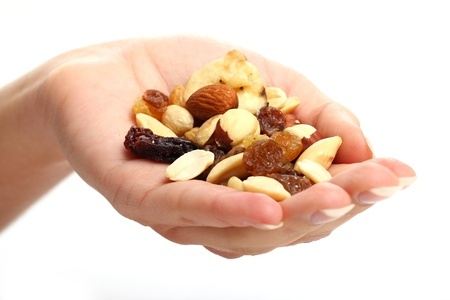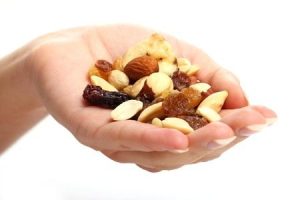
Misconceptions about how to lose weight are in no short supply. Heighten your success with clients by preventing them from falling victim to the hype that clever advertisers put on labels like “diet friendly”. In this post we’ll debunk some of the misinformation out there so you can feel good about coaching clients on the best practices for weight loss. Here is the truth behind 5 top diet myths.
1. You should only consume low-fat products if you are trying to lose weight.
For decades we’ve been told eating too much fat will lead to weight gain and in some cases obesity. This may sometimes be true, but usually the culprit here is not so much fat individually but rather those refined carbs and added sugars you find in highly processed foods. When we have too much of these products they then get stored as fat in the body. Think about it this way, how easy is it to scarf down a box of doughnuts (refined carbs and sugars) vs. a jar of peanut butter (fat)? Time to reexamine this low-fat falsity.
Several studies were actually done comparing the effect of a low-fat diet vs. a low-carb diet and results showed participants on the low-carb diet lost an exponential amount of weight in comparison to the low-fat group (1,2).
Not only does eating a high fat diet show improved weight loss but it can also reprogram your metabolic state to burn through fat. A study showed how a high-fat diet shifted the act of storing fat in the body to utilizing it as energy in between meals (3).
Takeaway: Fat is not the enemy here. Most of the excess fat in the body comes from consuming highly processed carbohydrates and added sugar. A high-fat diet can help you burn through fat rather than store it. Say it out loud: “Fat is my friend”.
Fat Friends: nut butters, avocado, raw nuts, coconut oil, olive oil, ghee, and cheese (i.e. feta, mozzarella string cheese, swiss, cottage cheese, cheddar, goat cheese, parmesan)

2. You won’t lose weight unless you’re counting calories.
For starters this is not a realistic or long lasting method for weight loss for many people. Not only is it time consuming but it takes the joy out of meal time. And this whole idea that all calories are created equal is absolute nonsense! Snacking on 300 calories worth of chocolate chip cookies is the not the same as snacking on 300 calories of walnuts and a slice of cheddar cheese.
Instead of focusing on how many calories you’re consuming, bring your attention to the types of foods filling your plate during each meal. If your plate is well-balanced (i.e. includes whole food groups: protein, whole grains, fruits, vegetables, healthy fats) you can be rest-assured you’re getting a healthy dose of nutrients and won’t overdo it. When you’re eating meals consisting of a variety of whole foods you’ll find yourself filling up on less because your plate is loaded with fiber, healthy fat, and protein to keep you full.
Takeway: Not all calories are created equal and for sustainable weight loss counting calories is not realistic. Stick to meals consisting of whole foods to take the guess work out so you can relax and thoroughly appreciate the food you’re putting into your body.
3. Protein bars are healthy.
Protein bars are marketed as a healthy snack alternative or meal replacement for when you’re on the go. Problem is though, many protein bars are extremely high in sugar and usually low in fiber which helps keep you full. AND to top it off some aren’t even very high in protein!
A comparison was done between a Snickers Bar and a Luna Protein Bar (Nutz Over Chocolate) and calorically both were actually equivalent based off of the serving size (4). Though the sugar content was higher in the Snickers Bar, two of the biggest ingredients contained in the Luna Bar were organic brown rice syrup and organic dried cane syrup which are just fancy words for sugar (don’t let the word organic in the ingredients list fool you).
When putting the Luna Bar head to head with good ole plain Greek yogurt though, there’s very little competition. The Luna Bar contains 9 grams of protein and 10 grams of sugar per serving, whereas 1 cup of greek yogurt contains 17 grams of protein and 6 grams of sugar — can’t argue with the winner here!

Takeway: Most protein bars on the market are high in sugar which can lead to weight gain. Sticking to whole foods is always your best bet to getting in an adequate amount of protein.
Grab and Go High Protein Snack: When you’re on the go and need a high protein and low sugar snack, make batches of homemade trail mix using your favorite mixed raw nuts with bits of dark chocolate and put a handful in a container. Pair it with a piece of string cheese for an easy protein-powered and low sugar snack!
4. You should ditch the yolk of the egg and only consume egg whites when trying to lose weight.
Egg yolks have received such a bad rap because of their high cholesterol content. Cholesterol actually plays a very important role in the body. We need cholesterol to digest fat, and to produce hormones and Vitamin D. Eggs are actually one of the few foods naturally high in Vitamin D which is a vitamin many people are low in. The yolk essentially is the most nutritious part of the egg.
The yolk contains:
- Protein
- Carbohydrates
- Essential fatty acids
- Cholesterol
- Fat soluble vitamins (A,D, E, K)
- Selenium, calcium, phosphorus, and zinc
Egg whites on the other hand only consist of mainly protein with very little amounts of vitamins and minerals. Meanwhile egg whites are getting all the praise on your local diner’s “Lite Breakfast Fare” menu!
Studies reveal the cholesterol in egg yolks actually raises HDL (the “good” cholesterol) in the body, as well as transforming the LDL (the “bad” cholesterol) into a subtype not associated with cardiovascular disease. In fact, studies show there is no evidence that consumption of eggs is associated with the risk of cardiovascular disease (5,6). Perhaps the new saying should be, “An egg a day keeps the doctor away?”.
Takeaway: Eggs are actually extremely nutritious, yolk and all! The high amounts of cholesterol is not something to fear because it is actually beneficial in improving cholesterol levels as well as an asset to the body’s maintenance of good health.
5. If it’s diet, it’s good for me.
Just because something is labeled “diet” does not mean it is a healthy alternative to it’s non-diet counterpart.
Many diet drinks are made with artificial sweeteners such as aspartame (Equal, NutraSweet), saccharin, acesulfame-k (Sunett, Sweet One) or sucralose (Splenda) which provide a zero calorie alternative to sugar. Even though these substitutes are less caloric than real sugar, evidence does not show it being beneficial for the waistline. A study through the University of Texas Health Science Center San Antonio showed diet soft drink consumption is correlated with a greater waist circumference (7).
Other research showed that participants drinking diet soda were at higher risk for diabetes and metabolic syndrome than those who consume non-diet products (8,9).
A lot of this may have to do with the signals these zero calorie sweeteners send to the brain. These sweeteners trick your brain into thinking you’re feeding it all these calories and once it realizes that’s not the cause, you may find yourself feeling unsatisfied and reaching for something else high calorie to satisfy your taste buds.
The biggest reason drinking diet drinks is not beneficial to losing weight though is because they are empty calories. There is very little to no nutritive value to most diet soft drinks.
Takeaway: Diet soft drinks are not a healthy alternative when trying to lose weight because not only can they can cause you to crave more sweets and increase your waistline but they have also been linked to diabetes and metabolic syndrome. Plus, diet soft drinks provide no nutritional benefit.
Though research in the nutrition realm is constantly changing, especially when it comes to what’s “best” for losing weight and keeping it off, one thing remains the same: a whole plate of whole foods is always a whole lot better for you.
Do you have questions about any of these diet myths or others you’re suspicious of? Come ask Regina!
If you’re NFPT Certified join the community group to share tips and make friends.
References
- Brehm, B. J., Seeley, R. J., Daniels, S. R., & D’Alessio, D. A. (2003). A Randomized Trial Comparing a Very Low Carbohydrate Diet and a Calorie-Restricted Low Fat Diet on Body Weight and Cardiovascular Risk Factors in Healthy Women. The Journal of Clinical Endocrinology & Metabolism, 88(4), 1617-1623. doi:10.1210/jc.2002-021480
- Samaha, F. F., Iqbal, N., Seshadri, P., Chicano, K. L., Daily, D. A., Mcgrory, J., . . . Stern, L. (2003). A Low-Carbohydrate as Compared with a Low-Fat Diet in Severe Obesity. New England Journal of Medicine, 348(21), 2074-2081. doi:10.1056/nejmoa022637
- Sherman, H., Genzer, Y., Cohen, R., Chapnik, N., Madar, Z., & Froy, O. (2012). Timed high-fat diet resets circadian metabolism and prevents obesity. The FASEB Journal, 26(8), 3493-3502. doi:10.1096/fj.12-208868
- Shmerling, M. R. (2015, December 10). Are protein bars really just candy bars in disguise? Retrieved March 20, 2017, from http://www.health.harvard.edu/blog/are-protein-bars-really-just-candy-bars-in-disguise-201512158848
- Fernandez, M. L. (2006). Dietary cholesterol provided by eggs and plasma lipoproteins in healthy populations. Current Opinion in Clinical Nutrition and Metabolic Care, 9(1), 8-12. doi:10.1097/01.mco.0000171152.51034.bf
- Fernandez, M. L. (2012). Rethinking dietary cholesterol. Current Opinion in Clinical Nutrition and Metabolic Care, 15(2), 117-121. doi:10.1097/mco.0b013e32834d2259
- (n.d.). Retrieved March 20, 2017, from https://www.sciencedaily.com/releases/2011/06/110627183944.htm
- Lutsey, P. L., Steffen, L. M., & Stevens, J. (2008). Dietary Intake and the Development of the Metabolic Syndrome: The Atherosclerosis Risk in Communities Study. Circulation, 117(6), 754-761. doi:10.1161/circulationaha.107.716159
- Nettleton, J. A., Lutsey, P. L., Wang, Y., Lima, J. A., Michos, E. D., & Jacobs, D. R. (2009). Diet Soda Intake and Risk of Incident Metabolic Syndrome and Type 2 Diabetes in the Multi-Ethnic Study of Atherosclerosis (MESA). Diabetes Care,32(4), 688-694. doi:10.2337/dc08-1799

Regina Pellegrino is a certified Health Coach throughThe Institute for Integrative Nutrition, as well as a certified Fitness Specialist through San Diego Mesa College. She is currently working towards her accreditation as a Registered Dietitian Nutritionist. Her goal is to spread her thirst for knowledge and passion for living a healthy lifestyle by helping others achieve their optimal health. Learn more about Regina at http://






